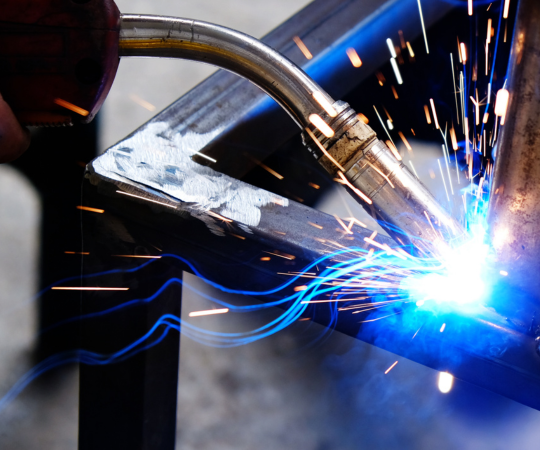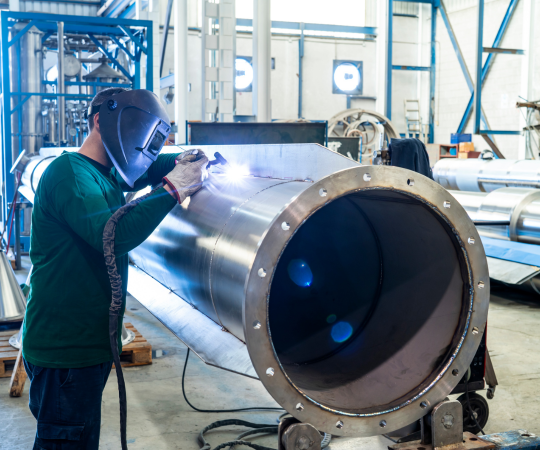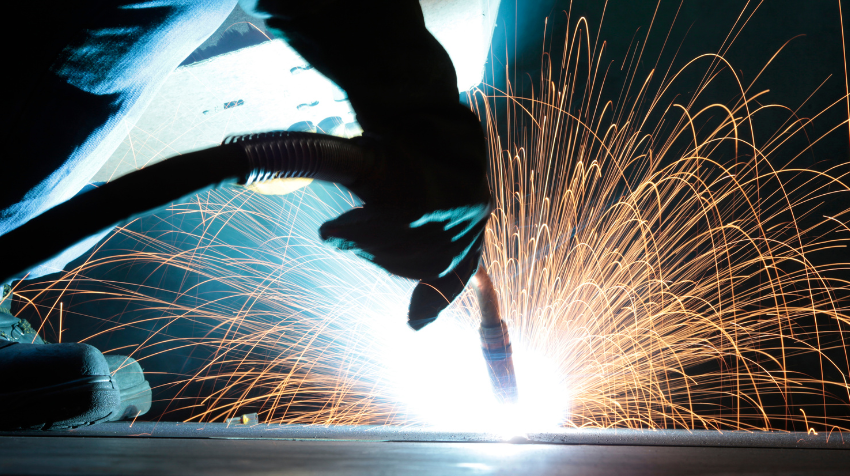Exploring Welding Techniques: A Comprehensive Analysis of Gas vs. Shielded Welding
Are you looking to expand your knowledge on welding types? If so, you’ve come to the right place.
In this article, we will be diving into the differences between gas and shielded welding. By understanding the basics of each type and comparing them side by side, you’ll gain a comprehensive understanding of when and where to utilize each method.
Gas welding is a popular technique that has been around for over 100 years. It involves heating metal with a flame fueled by gases such as acetylene or propane.
Shielded welding, on the other hand, uses a consumable electrode that melts and fuses with the metal being joined while also being protected from oxygen and nitrogen in the air by an inert shielding gas like argon or helium.
Each type has its unique advantages and disadvantages depending on the project’s needs. Keep reading to learn more about which type is best suited for various industries such as automobiles, construction, or aerospace.
Understanding the Basics of Gas Welding
You’re about to learn the basics of a welding technique that uses gas for its heat source. Gas welding techniques involve using a torch to melt two pieces of metal together, which is then cooled and fused into one solid piece. This process requires a gas flame, usually acetylene, as well as oxygen.
One of the main benefits of gas welding over shielded welding is that it allows for more control over the heat source. With gas welding, you can adjust the flame to create different temperatures and sizes depending on your needs. This makes it ideal for working with thinner materials or when precision is required.
Additionally, gas welding can be done without electricity or heavy machinery, making it a more portable option for those who need to work in remote locations or on-site repairs.
Now let’s move onto understanding the basics of shielded welding.

Understanding the Basics of Shielded Welding
Now that you’ve got the lowdown on the fundamentals of shielded welding, it’s time to delve deeper and really get your hands dirty. Shielded welding is a type of arc welding that utilizes a flux-coated electrode to protect the weld from air and other contaminants.
Here are some advantages and disadvantages of using shielded welding:
- Advantages: Shielded welding produces high-quality welds with good penetration and strong joints. It can be used on a variety of metals including steel, stainless steel, cast iron, and nickel alloys.
- Disadvantages: Shielded welding requires more equipment than gas welding as it involves a power source, electrode holder, ground clamp, and chipping hammer for slag removal.
For shielded welding, you will need a power source (either AC or DC), an electrode holder to grip the electrode during use, a ground clamp to complete the electrical circuit, chipping hammer or wire brush for removing slag after each pass.
Proper ventilation is also important when using shielded welding as it can produce harmful fumes and gases.
With this information in mind about shielded welding, let’s move onto comparing gas and shielded welding techniques in order to determine which one is best suited for your project needs.
Comparing Gas and Shielded Welding
Let’s take a closer look at how these two welding techniques stack up against each other and figure out which one will work best for your specific project needs.
When it comes to gas welding, it’s considered the more traditional method of welding, as it’s been around for over 100 years. Gas welding uses a flame produced by a mixture of oxygen and acetylene gases to melt the metal together. This method is known for its versatility, as it can be used on a variety of metals including steel, aluminum, copper, and brass.
On the other hand, shielded welding utilizes an electric arc that passes through an electrode and onto the metal surface, creating heat to melt the metal together. The electrode is coated in a substance that shields the weld from contamination. Shielded welding is widely used today due to its efficiency and effectiveness in producing high-quality welds. However, when comparing pros and cons between gas welding and shielded welding, cost may come into play as gas welding tends to be less expensive than shielded welding equipment-wise.
Moving on to industries where gas welding is commonly used…
Industries Where Gas Welding is Commonly Used
As you explore the industries that commonly rely on gas welding, you’ll discover a world of fiery sparks and skilled craftsmen expertly manipulating metal into intricate shapes.
Gas welding is often found in industries that require precise and delicate work, such as jewelry making, automotive repair, and plumbing. Advantages of gas welding include its ability to weld thin materials effectively and its versatility for working with different types of metals. However, there are also disadvantages to consider, including the need for a clean surface to ensure proper adhesion and the potential hazards associated with handling flammable gases.
Safety measures must be taken when using gas welding equipment. Protective gear such as gloves, eyewear, and clothing should always be worn to prevent burns or other injuries. Additionally, proper ventilation is necessary to prevent dangerous fumes from accumulating in enclosed areas.
With these precautions in place, gas welding can be a safe and effective method for achieving precise results in various industries. As we move forward into exploring industries where shielded welding is commonly used, it’s important to note the unique advantages and challenges presented by this type of welding process.
Industries Where Shielded Welding is Commonly Used
Industries rely on the precision and strength of shielded welding to create durable structures that can withstand harsh conditions. Shielded welding, also known as flux-cored arc welding (FCAW), is a type of welding that uses a continuously fed electrode wire that is coated in flux.
The flux produces a shielding gas that protects the weld from atmospheric contamination, resulting in stronger and more precise welds than those produced by gas welding. One advantage of shielded welding over gas welding is its ability to penetrate thicker materials and produce deeper welds. Additionally, it can be used in outdoor or windy conditions where gas shielding may not be effective.
However, shielded welding does have its limitations. It produces more smoke and fumes than gas welding, which can make it less desirable for certain industries such as food processing or electronics manufacturing where clean air is essential. Overall, each industry must consider the advantages and limitations of both types of welding before choosing which method to use for their projects.

Frequently Asked Questions
What are the different types of gas used in gas welding?
When it comes to gas welding, there are several types of gas that can be used. The most common types include acetylene, propane, and butane. Acetylene is the most popular choice due to its high temperature flame and versatility in various applications. Propane and butane are typically used for smaller jobs or where portability is necessary.
Gas welding offers numerous advantages such as producing a clean weld with minimal slag and being able to weld a wide range of materials. However, it also has some disadvantages such as requiring specialized equipment and posing a potential safety hazard if not handled properly.
Shielded welding, on the other hand, uses electrodes coated in flux to protect the weld from contamination and provide additional strength. It has its own set of advantages such as being more forgiving when it comes to technique and producing stronger welds than gas welding. However, it also has some drawbacks such as higher cost due to the need for additional consumables like electrodes and fluxes.
Both techniques have their place in various industries and it ultimately comes down to personal preference or job requirements when deciding which one to use.
Can shielded welding be used in outdoor environments?
Looking to use shielded welding for your outdoor projects? It’s definitely possible, but there are some things to consider.
One advantage of shielded welding is that it produces less smoke and fumes than gas welding, making it a better choice for outdoor use where ventilation may be limited. However, shielded welding can also be more difficult to control in outdoor environments due to wind and other weather conditions.
Additionally, the equipment needed for shielded welding can be more expensive than that for gas welding. Overall, if you’re experienced with shielded welding and have the proper equipment, it can be a great option for outdoor projects that require high-quality welds.
How does the cost of gas welding compare to shielded welding?
When it comes to welding, two popular options are gas welding and shielded welding. But which one is more cost-effective? Well, let’s take a closer look at the cost comparison and efficiency analysis.
Gas welding tends to be less expensive on the front end because it requires fewer materials and equipment. However, shielded welding can be more efficient in the long run because it produces less waste and requires less clean-up time. Additionally, shielded welding can provide stronger welds with less distortion.
Ultimately, deciding between gas and shielded welding will come down to your specific project needs and budget constraints. Regardless of which method you choose, both require skillful execution by an experienced welder to ensure quality results that meet safety standards. When considering the welding shielding gas, factors such as the type of metal being welded, the thickness of the material, and the desired strength and appearance of the weld should be taken into account. Additionally, the availability and cost of the shielding gas, as well as the portability of the welding equipment, may also influence the decision-making process. Ultimately, consulting with a professional welder or welding supplier can help ensure that you make the best choice for your specific welding project.
What safety precautions should be taken when performing gas welding?
When it comes to gas welding, safety measures are crucial. Before starting the process, make sure that you have all the necessary equipment requirements in place.
This includes a proper ventilation system to prevent inhalation of toxic fumes and gases. It’s also important to wear protective gear such as gloves, goggles and a welding helmet to avoid injuries from flying debris or sparks.
Additionally, ensure that there is no flammable material nearby and have a fire extinguisher handy in case of emergencies. By taking these precautions seriously, you can perform gas welding safely and effectively without any mishaps or accidents.
Are there any limitations to the thickness of materials that can be welded using shielded welding?
When it comes to welding, thickness is an important factor to consider. Shielded welding has some limitations when it comes to welding thick materials. Compared to gas welding, shielded welding typically cannot weld materials that are thicker than ⅜ inch.
This is because the shielding gas used in shielded welding is not as effective at penetrating and protecting the weld pool from impurities as the gas used in gas welding. This limitation can be overcome by using multiple passes or changing the settings of the machine, but this adds time and complexity to the process.
So if you’re looking for a more efficient way to weld thicker materials, gas welding may be a better option for you. When comparing these two types of welding processes, it’s important to understand their strengths and limitations before deciding which one is right for your project.
Conclusion
Congratulations! You’ve now gained a deeper understanding of the differences between gas and shielded welding. You’ve learned that gas welding involves heating metal with a flame fueled by acetylene or propane, while shielded welding uses a wire electrode and an inert gas to protect the weld from contaminants.
After comparing these two types of welding, you may have noticed that each has its unique advantages and disadvantages. Gas welding is commonly used in industries such as automotive repair, plumbing, and metal sculpture due to its versatility and low cost. Shielded welding, on the other hand, is preferred for industrial applications such as shipbuilding and aerospace manufacturing because it produces stronger welds.
Did you know that according to a recent study by Grand View Research Inc., the global market for shielded welding is projected to reach $16.2 billion by 2025? This statistic shows just how important shielded welding has become in today’s industrial landscape. As industries continue to evolve and demand higher quality welds, it’s likely that this number will only continue to grow.
As someone who now understands the ins-and-outs of these two types of welding, you’ll be better equipped to make informed decisions about which method is best suited for your project needs. Whether you’re looking for versatility or strength, both gas and shielded welding have their place in modern industry.
So go forth with confidence knowing that your knowledge will help you succeed!
Related Source

